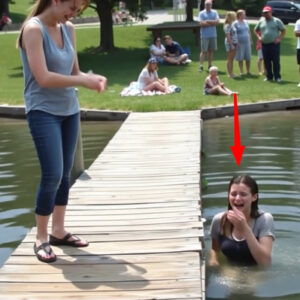The morning mist still clung to the asphalt of Riverside Road when Elena Martinez began her daily walk at 6:30 AM. As a retired teacher living alone on the outskirts of Millbrook, these early morning walks had become both exercise and meditation—a peaceful way to start each day before the world awakened and filled with noise and urgency. The rural road she favored was rarely traveled at this hour, offering her the solitude she craved after thirty-seven years of managing boisterous high school students.
Elena had always been observant by nature, a trait that had served her well in the classroom where she could spot trouble brewing from across the room. This morning, that same instinct made her pause when she noticed movement in the distance where the road curved around a stand of old oak trees.
A large dog appeared around the bend, walking with the purposeful gait of an animal on a mission. As it drew closer, Elena could see it was a magnificent German Shepherd, its black and tan coat gleaming even in the dim morning light. The dog moved with confidence and discipline, clearly well-trained, but what caught Elena’s attention most was the white plastic bag it carried carefully in its mouth.
The bag appeared substantial—not a small trash bag or forgotten item, but something deliberately packaged and sized. The Shepherd held it with the gentle precision of a retriever trained to carry game without damaging it, yet there was nothing recreational about this scenario. The dog’s focused demeanor suggested this was work, not play.
Elena pressed herself against the split-rail fence that lined this section of the road, instinctively trying to make herself less visible. She had always been comfortable around dogs, but something about this situation felt unusual enough to warrant caution. The Shepherd paid her no attention whatsoever, continuing its steady progress along the centerline of the empty road.
As the dog approached the intersection where Riverside Road met County Route 15, Elena heard the sound of an approaching vehicle. A dark sedan—she couldn’t make out the make or model from her position—rounded the corner and came to a stop directly beside the German Shepherd.
What happened next occurred so quickly that Elena almost questioned whether she had seen it correctly. The driver’s door opened, and a man in dark clothing leaned out. Without shutting off the engine, without any apparent communication with the dog, he simply reached down and took the white bag from the Shepherd’s mouth. The dog released it willingly, as if this transaction were completely routine.
The entire exchange took less than ten seconds. The man closed his door, and the car accelerated away, disappearing around the bend in the direction it had come. The German Shepherd, now free of its burden, calmly turned around and began walking back along the same route it had traveled, passing Elena’s hiding spot once again with the same focused indifference it had shown before.
Elena remained frozen against the fence for several minutes after both dog and car had disappeared, trying to process what she had witnessed. The exchange had been too smooth, too practiced to be coincidental. Someone had trained this dog to carry that bag to this exact location at this exact time, and someone else had known to be waiting there to collect it.
Her first instinct was to dismiss the incident as some quirky but harmless arrangement between neighbors. Perhaps an elderly person was using their well-trained dog to deliver items to a friend or relative who drove by on their way to work. But something about the stealth and speed of the transaction nagged at her. Legitimate errands didn’t typically require such secrecy and precision timing.
Elena continued her walk, but the strange scene played repeatedly in her mind throughout the day. That evening, she found herself researching German Shepherds online, learning about their intelligence, trainability, and historical use in police and military work. Everything she read confirmed that this breed could easily be taught to perform complex tasks with minimal supervision.
The next morning, she deliberately arrived at her usual walking spot fifteen minutes earlier, positioning herself with a clear view of the intersection while remaining partially concealed behind a large maple tree. At exactly 6:45 AM, the German Shepherd appeared again, carrying an identical white bag with the same careful precision.
Elena checked her watch: 6:47 AM. Two minutes later, the same dark sedan appeared and executed the identical exchange. The timing was so precise it could have been choreographed. This was clearly not a casual favor between neighbors, but a carefully orchestrated operation.
Her curiosity now thoroughly aroused, Elena made a decision that would have seemed unthinkable to her cautious nature just days earlier. She would follow the dog and see where it came from.
Maintaining what she hoped was a safe distance, Elena tracked the German Shepherd as it completed its return journey. The dog turned off Riverside Road onto Millfield Lane, a narrow gravel road that Elena had never explored despite living in the area for three years. The lane wound through increasingly dense woods before emerging into a clearing where several ramshackle buildings stood in various states of decay.
The dog approached what had once been a substantial farmhouse but now showed signs of long neglect. Sections of the wraparound porch sagged dangerously, windows were boarded or covered with heavy curtains, and the once-white paint had weathered to a dingy gray. Yet there were subtle signs of current occupation: a newer-model pickup truck parked beside the house, electrical lines that appeared to be in good repair, and the faint glow of light coming from behind the covered windows.
Elena positioned herself behind an abandoned barn about fifty yards away and watched as the front door opened to admit the returning Shepherd. A man appeared briefly in the doorway—tall, thin, wearing work clothes—but she was too far away to make out his features clearly. He appeared to check the dog over briefly before both disappeared inside, closing the door behind them.
That evening, Elena wrestled with her conscience. Every instinct told her that she had stumbled onto something illegal, but she also recognized that her suspicions were based entirely on unusual behavior rather than concrete evidence. What if she was wrong? What if this was some elaborate but legitimate business arrangement that she simply didn’t understand?
But sleep eluded her as she imagined various scenarios that could explain what she had witnessed. Drug trafficking was the obvious possibility—using a dog as a courier would be brilliant in its simplicity. Who would suspect a German Shepherd of criminal activity? Even if police or other authorities noticed the animal, it would appear to be a lost or stray dog, not a delivery system for illegal goods.
The next morning, Elena made another fateful decision. Instead of her usual early walk, she drove to a parking area about half a mile from the abandoned farmhouse and approached on foot through the woods. Her plan was simply to observe from a safe distance and see if she could gather more information about what was actually happening at the property.
What she discovered when she crept close enough to peer through a gap in the covered windows changed her understanding of the situation completely. The interior of the house had been converted into what was clearly a drug processing operation. Tables were covered with scales, plastic bags, and various chemical equipment. The acrid smell that drifted from the building made her eyes water and her throat burn.
Most shocking of all was the German Shepherd, sitting patiently beside one of the work stations while the same thin man she had seen before methodically divided white powder into small plastic bags—bags identical to the ones the dog had been carrying.
Elena’s hands shook as she fumbled for her cell phone. This was no longer about satisfying curiosity or solving a minor mystery. She had discovered a major drug operation, and an innocent animal was being exploited as an integral part of the distribution system.
The 911 call was brief and factual. Elena provided the address, described what she had observed, and emphasized that there appeared to be an active drug processing operation on the property. The dispatcher assured her that officers would respond immediately and advised her to leave the area for her own safety.
Elena retreated to her car and drove home, her heart pounding with a mixture of fear and moral satisfaction. She had done the right thing, but she also understood that her quiet rural neighborhood was about to become the center of significant police activity.
The raid occurred at dawn the following day. Elena watched from her front yard as multiple police vehicles, including a specialized drug enforcement unit, converged on Millfield Lane. The operation was swift and professional—within two hours, three men had been arrested and a substantial quantity of processed drugs had been seized.
The story that emerged over the following weeks was both more complex and more disturbing than Elena had imagined. The arrested men were part of a regional drug trafficking network that had been operating for over two years. The farmhouse served as both a processing facility and a distribution hub, with the German Shepherd being used to transport finished products to various pickup points throughout the county.
Detective Sarah Chen, who led the investigation, later explained to Elena how the operation had worked. “They had trained that dog to follow specific routes at precise times, delivering packages to predetermined locations where buyers or other distributors would be waiting. It was ingenious in its simplicity—who’s going to stop and search a German Shepherd out for a walk?”
The dog, whose name turned out to be Max, had been acquired as a puppy specifically for this purpose. The criminals had exploited his natural intelligence and eagerness to please, training him to perform deliveries without understanding the illegal nature of his work. To Max, this was simply a daily routine that earned him praise and treats from his handler.
The case made headlines throughout the region, not just because of the substantial drug seizure but because of the unusual method of distribution. Animal welfare advocates expressed outrage at the exploitation of an innocent animal for criminal purposes, while law enforcement officials warned that criminals were becoming increasingly creative in their efforts to avoid detection.
The three arrested men were ultimately convicted on multiple charges including drug trafficking, money laundering, and animal cruelty. The leader of the operation, Marcus Webb, received a sentence of fifteen years in federal prison. The abandoned farmhouse was demolished as part of the environmental cleanup required to remove the chemical contamination from the drug processing.
As for Max, his story had a happier ending. Detective Chen, who had developed a soft spot for the exploited German Shepherd during the investigation, decided to adopt him after he completed a rehabilitation program designed to help him unlearn his criminal training. The process took several months of patient work with a professional dog trainer, but Max eventually adapted to life as a normal family pet.
Elena visited Max several times during his rehabilitation, bringing treats and witnessing his gradual transformation from a precisely programmed delivery system back into a playful, affectionate dog. The experience was profoundly moving for her, seeing how completely the animal had been manipulated without understanding the harm he was unwittingly causing.
Six months after the arrests, Elena received a commendation from the county sheriff’s department for her role in exposing the drug operation. Sheriff Robert Martinez praised her courage and persistence in following up on suspicious activity, noting that her observations had led to the seizure of over fifty thousand dollars worth of processed drugs and the disruption of a major trafficking network.
“Too often, people see something unusual but convince themselves it’s not their business,” Sheriff Martinez said during the brief ceremony. “Mrs. Martinez’s willingness to trust her instincts and take action prevented countless doses of dangerous drugs from reaching our community.”
The experience changed Elena’s perspective on her role as an observer in her community. She realized that her teacher’s instincts for spotting trouble could serve a valuable purpose beyond the classroom. She began participating in neighborhood watch programs and maintained regular contact with local law enforcement, serving as an extra set of eyes in her rural area.
The case also highlighted important questions about the intersection of animal welfare and criminal justice. Legal experts noted that while using animals in criminal operations was not new, the level of sophisticated training involved in Max’s case was unusual and disturbing. New legislation was proposed to increase penalties for criminals who exploit animals in the commission of other crimes.
Dr. Amanda Foster, an animal behaviorist who worked with Max during his rehabilitation, used his case to educate the public about the remarkable intelligence and trainability of dogs, while emphasizing the responsibility that comes with that capability.
“Dogs like Max demonstrate incredible cognitive abilities,” Dr. Foster explained. “They can learn complex sequences of behavior and execute them with remarkable precision. But they’re also completely dependent on humans to guide that intelligence toward positive purposes. When someone exploits those abilities for criminal gain, it’s a profound betrayal of the trust that exists between humans and domestic animals.”
The farmhouse property was eventually purchased by a local conservation group and converted into a nature preserve, erasing the last physical evidence of the criminal operation that had once flourished there. A small educational trail was created, with signs explaining the importance of community vigilance in protecting both human and animal welfare.
Elena continued her morning walks along Riverside Road, but she never again took the peaceful rural setting for granted. She understood now that criminal activity could establish itself anywhere, often hiding behind facades of normalcy and innocuity. Her experience had taught her that ordinary citizens could play crucial roles in maintaining the safety and integrity of their communities, simply by paying attention and being willing to act when something didn’t seem right.
The intersection where she had first witnessed the strange exchange between dog and car was now just another quiet corner in her daily routine, but Elena always paused there for a moment, remembering the morning when her curiosity and courage had helped expose a network of criminals and rescue an innocent animal from exploitation.
Max, now living happily with Detective Chen’s family, had learned new routines that involved playing fetch with children, learning tricks for treats, and sleeping peacefully on a comfortable dog bed rather than being awakened before dawn to make mysterious deliveries. His story served as a reminder that animals, like people, deserve protection from those who would exploit their trust and loyalty for harmful purposes.
The case remained a talking point in law enforcement circles for years, cited as an example of how criminals adapt their methods to avoid detection and how community awareness can serve as the first line of defense against such innovations. It also stood as testament to the idea that paying attention to unusual patterns of behavior, even when they seem harmless on the surface, can sometimes reveal serious criminal activity hiding in plain sight.
Elena’s story demonstrated that heroism doesn’t always require dramatic action or special training. Sometimes it simply requires the courage to trust your instincts, investigate when something seems wrong, and take responsibility for the safety and welfare of your community—including its most vulnerable and innocent members.
The white bag that had started it all became a symbol in the case files—a reminder that criminal operations often depend on the assumption that ordinary people won’t look too closely at unusual but seemingly harmless activities. Elena’s decision to look closer, to follow the dog, and to trust her growing suspicions had unraveled an entire network of criminal activity and demonstrated the power of an engaged and observant citizenry.





